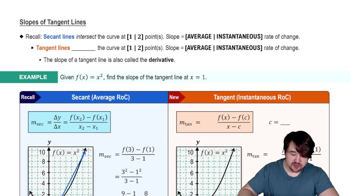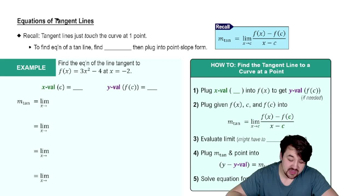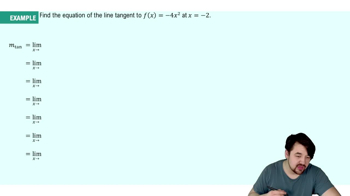Table of contents
- 0. Functions7h 52m
- Introduction to Functions16m
- Piecewise Functions10m
- Properties of Functions9m
- Common Functions1h 8m
- Transformations5m
- Combining Functions27m
- Exponent rules32m
- Exponential Functions28m
- Logarithmic Functions24m
- Properties of Logarithms34m
- Exponential & Logarithmic Equations35m
- Introduction to Trigonometric Functions38m
- Graphs of Trigonometric Functions44m
- Trigonometric Identities47m
- Inverse Trigonometric Functions48m
- 1. Limits and Continuity2h 2m
- 2. Intro to Derivatives1h 33m
- 3. Techniques of Differentiation3h 18m
- 4. Applications of Derivatives2h 38m
- 5. Graphical Applications of Derivatives6h 2m
- 6. Derivatives of Inverse, Exponential, & Logarithmic Functions2h 37m
- 7. Antiderivatives & Indefinite Integrals1h 26m
- 8. Definite Integrals3h 25m
2. Intro to Derivatives
Tangent Lines and Derivatives
Problem 99c
Textbook Question
The population of the United States (in millions) by decade is given in the table, where t is the number of years after 1910. These data are plotted and fitted with a smooth curve y = p(t) in the figure. <IMAGE><IMAGE>
Estimate the instantaneous rate of growth in 1985.
 Verified step by step guidance
Verified step by step guidance1
Identify the value of t corresponding to the year 1985. Since t is the number of years after 1910, calculate t = 1985 - 1910.
Locate the smooth curve y = p(t) on the graph that represents the population data. This curve will help us estimate the instantaneous rate of growth.
Determine the derivative of the function p(t), denoted as p'(t), which represents the instantaneous rate of growth of the population.
Evaluate the derivative p'(t) at the value of t calculated in step 1 to find the instantaneous rate of growth in 1985.
Interpret the result from step 4 in the context of the problem, explaining what the instantaneous rate of growth means for the population in that year.
Recommended similar problem, with video answer:
 Verified Solution
Verified SolutionThis video solution was recommended by our tutors as helpful for the problem above
Video duration:
4mPlay a video:
Was this helpful?

 5:13m
5:13mWatch next
Master Slopes of Tangent Lines with a bite sized video explanation from Nick
Start learningRelated Videos
Related Practice




